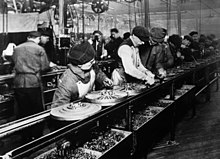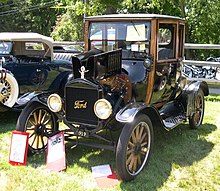U. S. Government/Transportation/The Automobile


In the 1920s, American's lives changed in many ways. One of the biggest changes was the introduction of the automobile to ordinary people. Cars had been built since the 1890s, but they were extremely expensive. Only the rich could afford them!
Henry Ford wanted to make cars available to more people. He moved to Detroit, Michigan, where he designed and built his first car in his home workshop. Later, he built a racing car called "999". It set a world speed record of 91 miles per hour. He started the Ford Motor Company in 1903.
Ford figured out how to build cars inexpensively. In his factory, he used a moving assembly line. At first, Ford Motor Company produced only one type of car, called the Model T. The cars were put together while moving past a line of workers. Each worker would do one specific, simple job. Then, the car moved on to the next worker. The asssembly line made production fast and efficient. At the Ford plant, a finished car rolled off the assembly line every 10 seconds!
In 1908, the price of a Model T was $850. By 1916, the cost had been reduced to $360, and by 1924, the price was less than $300. Ford kept prices down by keeping his car design simple. The same model came out year after year. He joked that you could choose any color, as long as you chose black. Henry Ford achieved his dream of making cars available to everyone.
Other car companies copied Ford. Along with Ford, the General Motors Company and others made cars available to Americans. Millions of cars were sold. Because so many Americans were able to buy cars, the US changed in many ways.
Many other industries grew because of the automobile industry. Tires, glass, and paint had to be made for cars, so companies that made these products grew. Because the cars ran on gasoline, the oil business expanded.
Before the car became popular, people traveled mostly by horse and wagon. Since wagons were slow, the roads did not need to be smooth. They were bumpy, uneven, and unpaved. However, traveling 50 or 60 miles per hour in a car was impossible on these roads. Thousands of miles of roads had to be paved.
Americans could now travel for business and pleasure. Now, going on vacation to visit other places was much easier. People could also move to the suburbs and drive into the city to work each day. The car changed Americans' way of life forever.
